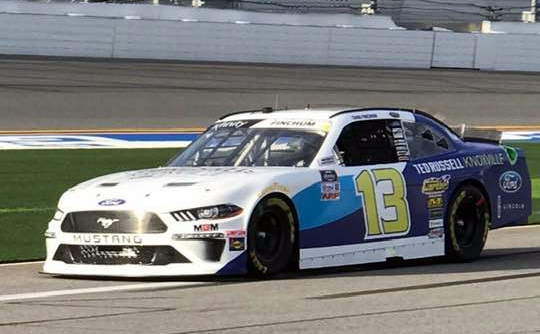
Martin Truex Jr. takes first place after an exciting stage one finish. Kevin Harvick jumps up three spots to be seventh. JGR gets their fourth win of this season behind Christopher Bell. Chase Elliott leads in points. It's all happening down in New Hampshire.
Martin Truex Jr. sweeps the stage
Martin Truex Jr. won stage one of the New Hampshire race and took the pole position. After a rain delay of approximately an hour, Ambetter 301 takes place on the 1.058 miles oval. Truex leads from the start, but Bubba Wallace comes out of nowhere to take second. Kyle Larson and Kyle Elliott are third and fourth, respectively. Kevin Harvick is currently seventh, just behind Aric Almirola. He has a great history at New Hampshire.
Martin Truex had a hard season so far. The Ambetter 301 however was a standout for him. He earned his first pole and led more laps than any other driver. He also won stages 1 and 2, putting him in a great place to progress through the playoffs.

Kevin Harvick rises three places to No. 7
Kevin Harvick is now seventh in the New Hampshire NASCAR results, moving up three spots from last year's sixth place. The four-time winner is just 19 points out of the Playoffs, and has a solid track record in New Hampshire. Harvick finished in the top 12 five times in six of the last six races. He has a +35 position differential, which makes him an attractive bet for a great finish at New Hampshire Motor Speedway.
Martin Truex Jr. was in the lead for a while, but Harvick drove the best car to challenge Truex Jr. and make it into the playoffs. The last caution came when Todd Gilliland spun. This resulted in a 93-lap green flag.
Christopher Bell leads JGR to fourth win of season
Christopher Bell has already made a strong start to his NASCAR Cup Series rookie season. His win at the Texas 500 was enough to secure him a spot on the playoffs. It could also open up the possibility for him to have an impact next season. Bell has proven his ability on road and short tracks to win, and is likely to challenge for the title in the next few years.
Bell is now 4-0 in Cup Series and has won two Xfinity Series races. He won three races this year, and one in 2018. Then he took his fourth win at New Hampshire Motor Speedway's Ambetter301. Chase Elliott, the Cup Series race winner, was the one he had to beat. Elliott had won this race a week ago.

Chase Elliott holds point lead after stage two
Loudon, New Hampshire is where the NASCAR Cup Series arrives. Martin Truex Jr. takes the lead row. Chase Elliott and he work in close proximity to each other to begin the race. They come into contact just before the first turn. However, Elliott manages to stay ahead of the race and avoid collision. Erik Jones makes contact, spins and turns across the track with Justin Haley. Alex Bowlicki makes contact with Elliott but Elliott remains at the front going into the second stage.
The race was delayed nearly two hours due to bad weather. Elliott led the race for 37 laps, despite a restart. After pitting for fuel, Elliott finished in third place. Later on, he pitted to get two tires but was careful and came back out in eighth. He later accumulated ten positions, including lead.
FAQ
Who was the first to race a car?
Charles Brady King, who in 1896 built Long Island's first automobile racecourse. July 4th was the day that the first auto race took part.
Can I watch a racecar driver race?
Yes. There are lots of ways to see a race car driver race.
You could purchase tickets to be there. It is also possible to watch the race online.
You can even follow the race via radio or TV.
What types of cars are race car drivers using?
Modern racing cars usually use engines. These engines are very similar to those used in normal passenger cars.
But instead of using petrol, they run on compressed air.
Is it possible to drive a racecar?
It takes hard work and dedication. It takes practice. If you don't put in the time and effort, you won't make it.
You must be willing sacrifice everything to achieve this dream. This is not a game in which you can win only if you are fast enough.
Many people are unable to drive and try unsuccessfully. They want a simpler lifestyle.
They want to go home every night, and they don't need to do any extra work. You have to be willing and able to give up all other things if you want success.
You have to work hard if you want race car driving.
Statistics
- In 2009, the slick tires returned as a part of revisions to the rules for the 2009 season; slicks have no grooves and give up to 18% more contact with the track. (en.wikipedia.org)
- According to AutoSport, IndyCar's top speeds are 380km/h or 236 mph. (motorbiscuit.com)
- According to thepostgame.com, “The Daytona 500 is one of four ‘restrictor plate' races on NASCAR's calendar, given both safety and competitive concerns for the long track and its famous 31-degree banking in its four corners.” (defensivedriving.com)
- This change may give an improvement of up to 29% fuel efficiency. (en.wikipedia.org)
- Acceleration is a little gentler (relatively speaking) too, with 0-100km/h taking an estimated 3.1 seconds and 0-200km/h covered in 7.8 seconds. (autosport.com)
External Links
How To
How to get around corners quickly
During a race, you want to get your car out of the way of others so you can go faster. This means that you must turn before everyone else. You will make others behind you brake if you do it correctly. You can also avoid collisions with cars coming in different directions. So how do you corner fast?
First, it is important to understand where your destination is. You will likely be surprised at where you end up. That's why you need to plan carefully. You can make a map of your route to help you see where you are at any moment. It may seem like a lot of work but once you have a good idea of the route you are trying to take, you will be able to save yourself a lot later.
Next, you should figure out when you're going to start turning. It's best to begin after passing the first corner. Once you pass the first corner, then you will know exactly where to begin. Now you just need to decide whether you'll use the inside lane or the outside lane.
If you plan to use the inside lane, wait until there is no traffic ahead of you. You'll then be able move quickly and not worry about hitting anyone. However, once you get into the inside lane you must remain there. You must not drift back to the outside lane. You could hit someone moving slowly if you do. Keep in mind that if you cross the line dividing the two lanes, you'll lose control of your vehicle and become vulnerable to crashes.
Once you have chosen the lane, it's time to decide where to turn. There are many options for tackling this problem. Some people prefer to find a gap in the traffic. Others try to find a clear opening in the road. Some others try to find a point where a road curves around a mountain or hill. It doesn't really matter which route you take, just make sure you don’t block the whole road. Traffic jams can be caused by blocking the entire road.
After you've picked a spot to turn, you need to decide whether you'll be making a sharp left or a gradual curve. A sharper turn is more difficult than a gradual. But it is more difficult and requires more energy. You may also find it difficult to control your car correctly. These are the main reasons why most drivers prefer gradual turns.
Finally, you need to accelerate just enough to escape the car in front of you. Accelerating too early will cause you to crash into its bumper. Running off the road will be a problem if you accelerate too soon. In either case, you'll lose control of your car and crash. You need to gradually accelerate in order to avoid this. Start with very little acceleration, and only increase it as you near the edge of the road.
When you've finished cornering, you need to slow down immediately. This is especially important when you're driving through heavy traffic. If you don't, you risk hitting someone.